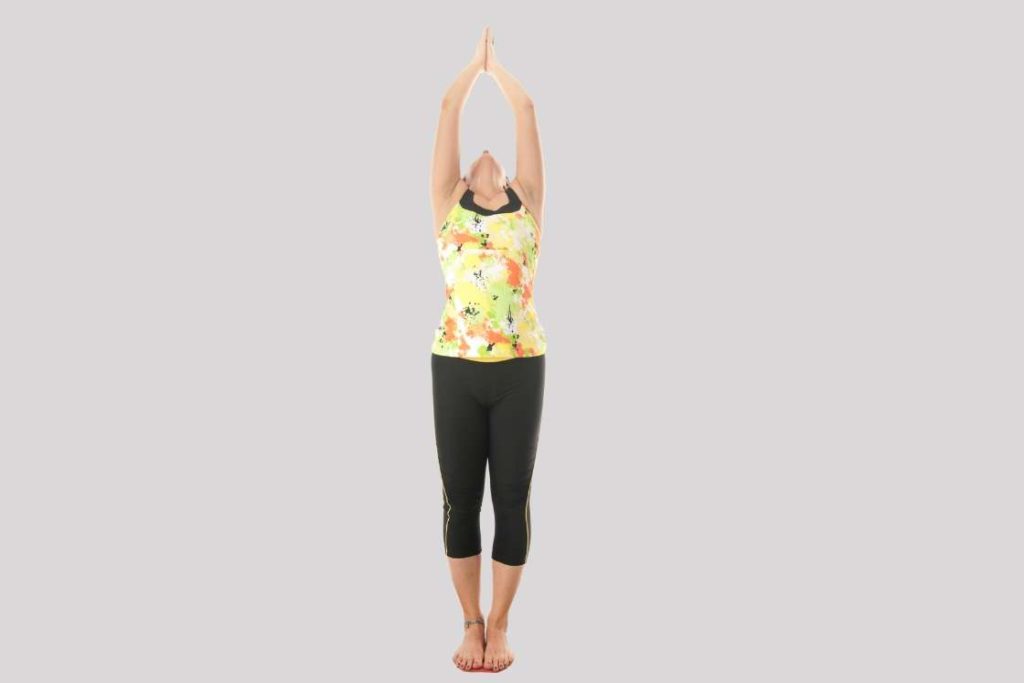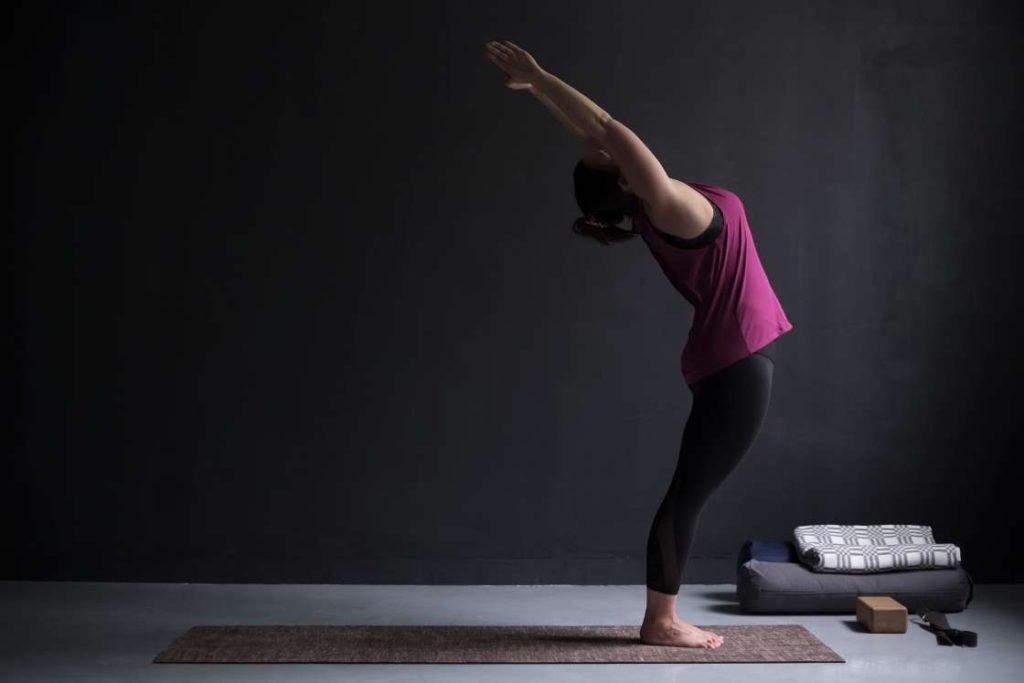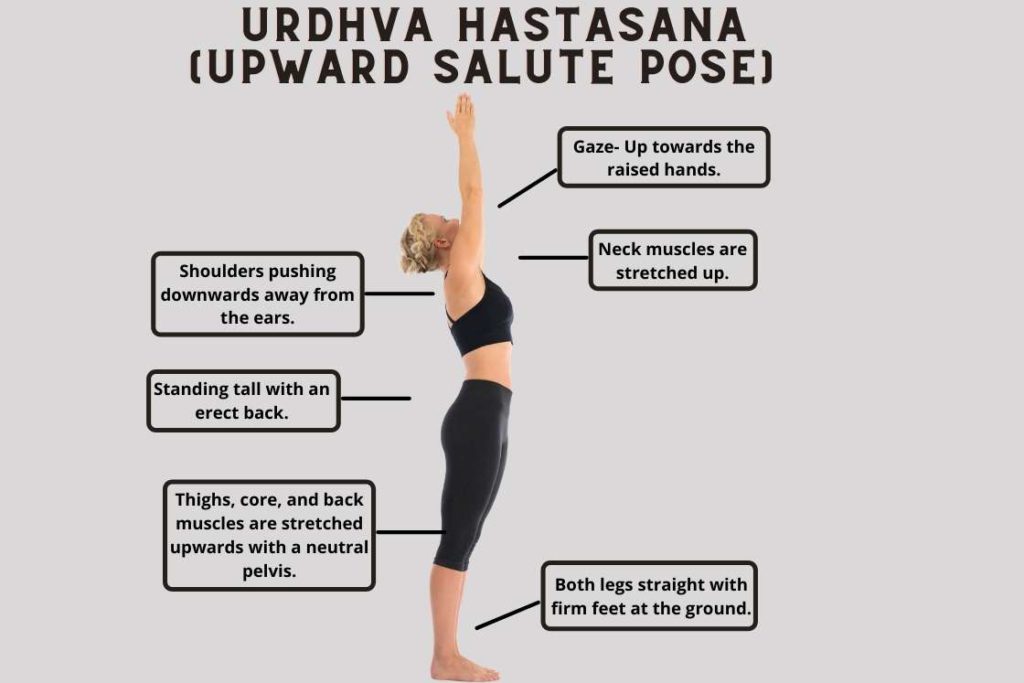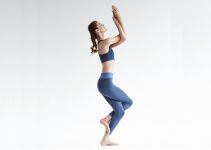
| Sanskrit Pronunciation | Urdhva Hastasana (OORD-vah hahs-TAHS-uh-nuh) |
| Meaning | Urdhva = raised (or upward / hasta = hand / asana = pose |
| Pose Type | Standing Stretch |
| Pose Level | Beginner |
| Anatomy | Arms and Shoulders, Upper Back, Neck, Psoas muscles |
| Other Names | Upward hand stretch pose, Upward Salute, Raised Hands Pose, Mountain Pose with Arms Overhead or Utthita Hasta in Tadasana Palm Tree Pose, Urdhva Hastotanasana |
Urdhva Hastasana is a standing pose that refreshes the entire body by boosting energy levels. Whether you are a trained yogi, an aspirant, or even a novice, anyone can perform this pose on a daily basis.
Every time you get up from long seated hours or wake up extending the arms overhead and stretching the entire body from toes to fingertips. This subconscious move re-energizes the body and forms Urdhva Hastasana.
Getting into the meaning, urdhva hastasana refers to “Raised Hands Pose”. It’s also called Upward Salute Pose due to the Namaste gesture of hands. This gentle stretch regenerates energetic spark and provides various therapeutic perks.
Urdhva Hastasana Practice Guide

Contraindications and Precautions
- Avoid it you have a sprain in and around the shoulders and neck.
- You can also try it without lifting the arms fully over the head if it is hurting when stretching in the full version.
- Ensure to master the alignments of basic tadasana before trying this pose. It will act as a preparatory pose to stretch and balance the body into Urdhva Hastasana.
- While lengthening the spine, pull the pubic bone towards the navel to prevent injury in lumbar spine and rib cage.
- Stack the knees over the ankles and shoulders exactly above the hips.
Urdhva Hastasana Procedure(Steps)

Follow these easy instruction to attain Urdhva Hastasana and experience its energetic benefits:
- Stand in tadasana keeping the feet 10cm apart and arms by the sides.
- Equally distribute the weight on both the feet and relax the arms, neck, and shoulders.
- Inhale raising the arms above your shoulders and head.
- Join the palms together overhead keep the feet grounded firmly.
- Draw the shin bones and knee caps upward and keep the thighs engaged while stretching upward.
- Inhale further and deepen the stretch by engaging the core muscles and stretching the neck muscles to look towards the raised hands.
- Hold the stretch for about 8-10 breaths and then sweep the arms back to the sides while exhaling.
- This completes one round of Urdhva Hastasana. Practice it for about 10 rounds and then relax.
Follow-up poses
The practice of Urdhva Hastasana is followed by inverted poses like Standing Forward Bend (Uttanasana) and Standing Sideways Bending pose.
Props and Modifications
- Beginners often struggle with keeping arms straight while raised upwards. To ease this challenge, try it with securing a loop around the upper arms holding them shoulder distant apart.
- Place a block between the upper thighs while stretching upward. It will squeeze the outer hips and push the tailbone down and neutralize the pelvis.
Urdhva Hastasana Variations
Perform these variant poses of Urdhva Hastasana to ease or deepen the pose;
1. Urdhva Hastasana with interlocked fingers
As the name reveals, it differs only in hand gesture. After standing with raised arms over the head, interlace the fingers and turn the palm upward. It will enhance the stretch on entire body.
2. Urdhva Hastasana balancing on toes
While stretching upward, lift your heels off the floor and shift the weight onto the toes. Gaze upward towards the raised or interlocked fingers. Therefore, in this variation the body is balanced only on the toes that makes it an advanced variant.
3. Urdhva Hastasana without raising arms
This variant of Urdhva Hastasana comes in handy when you are experiencing any pain around the shoulders or neck. Stand with lifting the body on toes and spread the arms beside you at shoulder level or join them in Anjali mudra at the chest.
Therapeutic Applications
- Urdhva Hastasana also improves the mental health and is proved beneficial in curing anxiety and stress.
- This pose is helpful in curing asthma and other lung disorders.
- It has remedial effects o on relieving the sciatica pain.
- This is an excellent stretch for getting rid of backache.
- Anyone suffering from upset stomach or dyspepsia must try Urdhva Hastasana
Urdhva Hastasana Benefits
1. Improves posture
This asana stretches the entire spine, relaxes the shoulders, and tones the body. The expansion of several muscles including the legs, arms, core, back, and hip muscles rectifies any postural deformity and provides a toned body.
2. Stimulates the digestive system
It stretches the core muscles which massages and tones the abdominal organs, viz. stomach, pancreas, and liver. This gently stretches the rectus abdominal muscles and the intestines. Thus, it improves the overall efficiency of the digestive system.
3. Enhances pulmonary efficiency
Urdhva Hastasana is assumed with the expansion of the chest and enhances the lung capacity. It facilitates diaphragmatic breathing and helps in maintaining a healthy respiratory system.
4. Improves blood circulation
The entire muscular system experience stretch in Urdhva Hastasana. This expansion of muscles clears up the muscular congestion by regulating proper blood supply throughout the body.
Conclusion
Get an instant rush of energy flowing through your body practicing Urdhva Hastasana any time of the day.
This pose prepares the body for advanced postures by improving the balance, strength, and body alignment. Therefore get ready to try it out and embrace the grace that it leaves on you.




